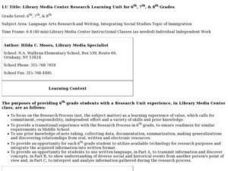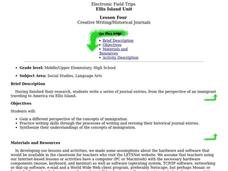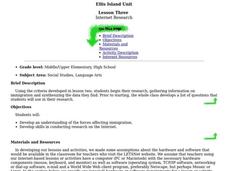Curated OER
Library Media Center Research Learning Unit for 6th, 7th, & 8th Grades
Students focus on the process of and skills necessary for researching a topic. They study the topic of immigration while practicing note taking skills, organizing information and writing conventions.
Curated OER
Immigration: A Cultural Perspective
Students investigate immigration and migration patterns near Pittsburgh, and distinguish between voluntary and involuntary migrants. They evaluate the importance of urban villages in relation to the immigrant experience.
Curated OER
Investigation of Immigration
Students assume the role of a crime scene detective and examine the lives of various immigrant groups. In this immigration activity, students examine evidence, websites, and pull from existing knowledge to determine which group they are...
Curated OER
The Brief American Pageant: The American People Face a New Century
The political landscape of Y2K is the focus of this series of slides, which cover the later years of the 20th century. Charts detail the poverty and social welfare rates in the 20th century, as well as a pie graph displaying the sources...
Curated OER
History of Immigration From the 1850's to the Present
Eleventh graders study the history of immigration from 1850 to the present. In this American History instructional activity, 11th graders compare the 1924 and 1965 immigration acts and give a reasoned opinion on each. Students...
Curated OER
Contemporary Immigration
Eleventh graders analyze the patterns and waves of immigrants that have come to the United States from 1850 to 2000. They participate in a class discussion about immigration, and in small groups conduct research analyzing and evaluating...
Curated OER
Island of Hopes and Island of Tears?
Third graders research Ellis Island. In this immigration lesson, 3rd graders watch a power point presentation titled Island of Hope or Island of Tears?and discuss the personal belongings the immigrants decided to bring to the United...
Curated OER
The Immigrant Experience
Students utilize oral histories to discover, analyze, and interpret immigration and migration in the history of the United States. A goal of the unit is fostering a discussion and encouraging students to make meaning of the bigger...
ProCon
Sanctuary Cities
Should sanctuary cities receive federal funding, or do they defy federal laws? That is precisely the question scholars attempt to answer as they prepare for a class discussion or debate. After reading some brief background information,...
Advocates for Youth
What Does Community Mean to Me?
Having a strong and supportive community is key for adolescent success. Teenagers explore the circles of their own communities, including the rights and responsibilities of being in their families, peer relationships, and their country,...
Teaching Tolerance
Changing Demographics: What Can We Do to Promote Respect?
America has always been seen as a melting pot to the world. Scholars research the concept of blending cultures in the United States and how it is changing over time. The final lesson of a four-part series analyzes the changing...
Curated OER
Gateway to America
Fifth graders study about immigration, Ellis Island, and tenement life from 1890 to 1924. They create an identity of a fictitious immigrant and describe what they find when they arrive in New York.
Curated OER
Creative Writing/Historical Journals
Students write series of journal entries, from the perspective of an immigrant traveling to America via Ellis Island.
Curated OER
Internet Research
Students research and gather information on immigration, synthesizing the data they find.
NPR
Civil Rights of Japanese-American Internees
Prompted by a viewing of Emiko and Chizu Omori’s Rabbit in the Moon, a documentary about the internment of Japanese-Americans during World War II, high schoolers examine a series of documents, including the Bill of Rights and the UN’s...
Curated OER
Consequences of the Sedition Act
Students research and discuss the consequences of the Sedition Act. They illustrate the difficulty of balancing security needs and personal freedom using an example from John Adams's presidency.
Curated OER
Book: Latino Economics in the United States: Job Diversity
Learners, after reading Chapter 1 in the book, "Latino Economics in the United States: Job Diversity," write an essay that compares the cultural as well as the historical factors (experiences with jobs, discrimination, education, etc.)...
Curated OER
Unauthorized Immigration and the U.S. Economy
High schoolers examine unauthorized immigration in the United States. In this current issues lesson, students examine 4 letters written to the editor regarding unauthorized immigration. High schoolers act as editors and analyze the...
Curated OER
Chart Reading - Uninsured in the United States of America
In this chart reading instructional activity, students click on the links to read different charts about health insurance in the United States and then answer short answer questions about it. Students complete 7 questions total.
Curated OER
Hispanic Immigration
Eighth graders interpret historical evidence presented in primary and secondary resources. In this immigration activity, students examine sources regarding the history of Hispanic immigration to the United...
Curated OER
Freedom Voices: Abolition and Suffrage in the United States
Learners explore abolition and suffrage in the United States.
Curated OER
Human Migration in the United States
Learners investigate the factors involved in human migration in the United States. Students analyze maps of different regions in the United States to determine how a variety of factors influence human settlement and development.
Curated OER
How Did the Immigrants Get to the United States?
Third graders search TDC database for images of immigration from other countries, maps, and diaries. They identify the challenges that immigrants had to endure to reach the United States.
Curated OER
Why Do Immigrants Come to the United States of America?
Students appreciate the diversity of motives for immigration to the United States. They gather first person data and develop a persuasive presentation. They create a historical comparison of the motives for immigration to the community.

























